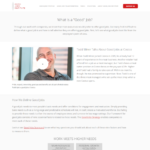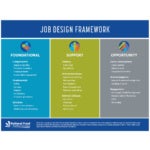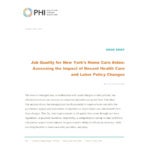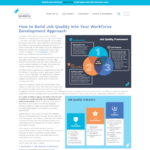Originally posted: May 11, 2020
Last updated: April 5, 2023
For too many people in the US, work isn’t working. In a 2019 Gallup survey of working adults, most respondents reported that their job quality had a strong influence on their quality of life. And more than half of respondents reported not having a quality job.
But what is a quality job? The job quality definitions and frameworks in this section provide a window into the range of attributes that drive worker experiences: wages, benefits, scheduling, legal rights, equity and inclusion, opportunity to build skills and advance, supportive work environment, and worker voice. Reviewing the tools and resources in this section can orient you to the job quality conversation, illustrate the dimensions of job quality, contribute to the development of your own working definition of job quality, and prepare you to discuss job quality with a range of audiences.
In Section 4 of the library, you will find tools and resources in eight sections organized by job quality attributes.
↓ Tools and Resources Below the Box ↓
Library Navigation
- Job Quality Tools Library Homepage
- About This Library
- Special: COVID-19 Response Tools and Resources
- Index of Tools by Field
Job Quality Definitions and Frameworks

The Aspen Institute Economic Opportunities Program – Job Quality Fellows Statement of Purpose
Who’s It For: Employers, Economic Development, Investing and Lending, Policy, Worker Advocacy, Workforce Development
What’s It For: This statement emerged from the collaborative work of the 2017-2018 Aspen Job Quality Fellows, innovators from diverse sectors who are working to expand quality jobs. It includes a list of key job quality attributes and a stated commitment to advance job quality. The statement offers a useful example for practitioners across fields seeking to define the elements of a quality job and publicly commit to job quality efforts.

Who’s It For: Employers, Economic Development, Investing and Lending, Policy, Worker Advocacy, Workforce Development
What’s It For: This shared definition of job quality was created collaboratively by leaders in business, labor, workforce development, and policy as part of the Good Jobs Champions Group, an initiative of the Aspen Institute Economic Opportunities Program and the Families and Workers Fund. The definition provides a framework for understanding job quality, dividing the components of a good job into three categories: economic stability, economic mobility, and equity, respect & voice.

Good Jobs Institute – What is a “Good” Job?
Who’s It For: Employers, Economic Development, Investing and Lending, Policy, Worker Advocacy, Workforce Development
What’s It For: MIT’s Good Jobs Institute created this framework to help employers seeking to improve worker experience, retention, and productivity to assess their performance across nine “essential elements” of a quality job. These include meeting an employee’s basic needs, such as through fair wages and a flexible schedule, and meeting “higher needs” such as personal growth, belonging, and recognition. While designed for employers, the framework has relevance for all practitioners seeking to define and assess job quality in an organization.

National Fund for Workforce Solutions – Job Design Framework
Who’s It For: Employers, Economic Development, Investing and Lending, Policy, Worker Advocacy, Workforce Development
What’s It For: This framework can help employers and their partners define job quality and design high-quality job opportunities in collaboration with workers, based on a menu of components of a quality job. The tool is built around three pillars that can help to attract and retain talent: foundational elements of a quality job such as wages and benefits, support elements such as training, and opportunity elements such as recognition.

Who’s It For: Employers, Economic Development, Investing and Lending, Policy, Worker Advocacy, Workforce Development
What’s It For: This discussion paper is designed to help Community Development Financial Institutions (CDFIs) define and measure job quality. It defines a quality job as one that contains most (if not all) of five elements: a living wage, basic benefits, career-building opportunities, wealth-building opportunities, and a fair and engaging workplace. The paper offers impact measurement practices to assess and report on job quality to help CDFIs encourage and support their business borrowers to enhance the quality of jobs they offer. While this resource is written for lenders, it has applications for all practitioners seeking to define and measure job quality within a firm.

PHI – Nine Elements of a Quality Caregiving Job
Who’s It For: Employers, Economic Development, Investing and Lending, Policy, Worker Advocacy, Workforce Development
What’s It For: This issue brief by PHI analyzes the impacts of recent policy changes in New York state impacting home care aides and defines what a quality job looks like for a caregiver. The elements of a quality job in this occupation are organized in three categories: compensation, opportunity, and supports. While designed for care workers, the framework has relevance across industries and application for all practitioners seeking to define and assess job quality in an organization.

San Diego Workforce Partnership – How to Build Job Quality into Your Workforce Development Approach
Who’s It For: Policy, Workforce Development
What’s It For: The San Diego Workforce Partnership developed this list of seven actionable steps workforce development practitioners can take to assess and improve job quality. Strategies relate to spending, employer engagement, partnerships, building worker power, and measuring success. The Workforce Partnership also provides a job quality framework and list of job quality indicators. Although designed for workforce practitioners, this tool can also be informative for others interested in strategies to improve job quality, including policymakers and economic development professionals.
Supplemental Resources: Why Job Quality
- The Aspen Institute Economic Opportunities Program and PHI – Raise the Floor and Build Ladders. This foundational brief (originally published in 2014) encourages the workforce development field to implement a broader range of workforce interventions to improve the lives of workers in low-wage work by focusing on both career mobility and basic economic stability. It provides a useful framework for job quality efforts, identifying approaches that not only build ladders, or help low-wage workers advance into better jobs, but also raise the floor, or help make workers’ current jobs more stable so that they can take advantage of upskilling and mobility opportunities.
- Steven L. Dawson – The Pinkerton Papers: Job Quality Series. This series of publications for workforce professionals explains why the time is right to focus on job quality work and offers a series of practical recommendations for job training programs seeking to deepen their employer engagement and strengthen support for lower-income workers.
- Zeynep Ton – The Case for Good Jobs. This Harvard Business Review article, written by a professor of operations at MIT Sloan School of Management, explains research findings about why good jobs—those with livable wages, predictable hours, training, and opportunity for promotion and growth—can also make retail businesses more stable and competitive. This article can be used to understand the business case for the “Good Jobs Strategy,” which involves investing in labor while strengthening operational effectiveness.
- Brookings Institute – Prioritizing Job Quality. This article explains the need for heightened attention to job quality and shares strategies that practitioners across the private, public, and non-profit sectors can implement to increase the number of quality jobs.
- Cornell Law School – Job Quality Index. The U.S. Private Sector Job Quality Index (JQI) is intended to reflect job quality in the United States by capturing and reflecting data related to weekly wages and hours for higher-wage jobs versus lower-wage jobs. Released each month on the same day as the Bureau of Labor Statistics’ U.S. Employment Situation Report, it captures a distinct view of labor market health and offers monthly tracking of the composition of high-to-low quality jobs. Historic data also documents a shift from jobs in manufacturing to services, as well as a shift within services from higher to lower-quality jobs.
- Gallup – Not Just a Job: New Evidence on the Quality of Work in the United States. This report details the findings from a randomized 2019 Gallup survey of over six thousand American workers to understand their perspectives on job quality. The study offers a definition of job quality based on ten dimensions workers care about and provides useful findings and implications about who has a quality job and how job quality impacts quality of life.
- San Diego Workforce Partnership – Job Quality Framework. This Job Quality Framework outlines the San Diego workforce board’s job quality features as well as indicators for measuring job quality. This framework provides useful guidance for employers, workforce development professionals, worker advocates and others who are interested in defining and measuring job quality.
- Urban Institute – Understanding Good Jobs: A Review of Definitions and Evidence. This report examines definitions and research on job quality and provides a job quality framework based on findings. As the authors note, the report has a particular focus on job quality elements with potential to support economic mobility. Designed to provide common ground for discussions around job quality, this report may be useful for practitioners and employers interested in exploring job quality frameworks as well as the link between job quality elements, worker wellbeing, and upward mobility.
- Workforce Professionals Training Institute – Job Quality for Frontline Workforce Professionals. The Voices from the Frontline initiative produced this brief to elevate the conversation around job quality in the workforce development field and what a focus on job quality for frontline workforce professionals could look like in practice. In addition to quantitative measures such as wages, the authors note that feeling a sense of purpose and ownership over one’s work can be beneficial for workforce professionals and the workers they serve. This publication has application for workforce development organizations as they work to assess and improve their own internal job quality metrics.